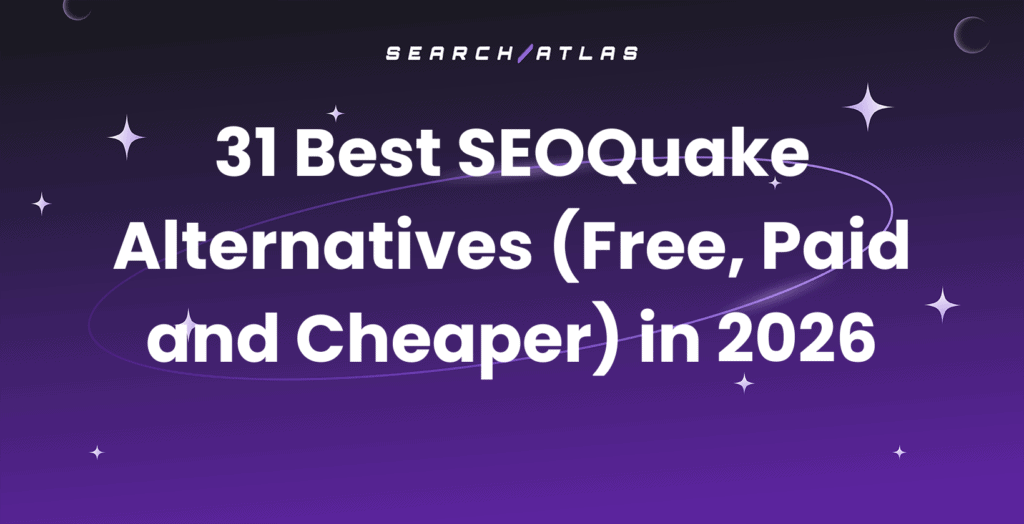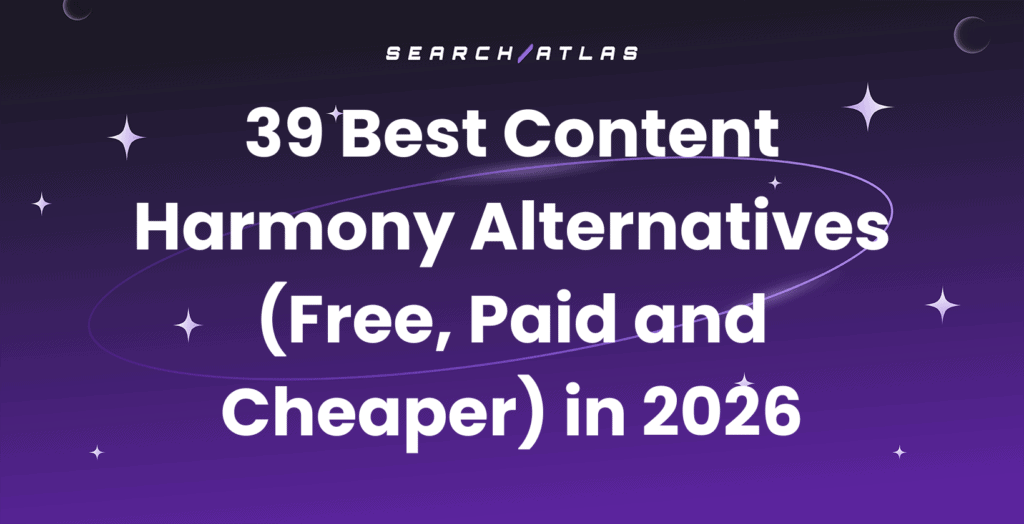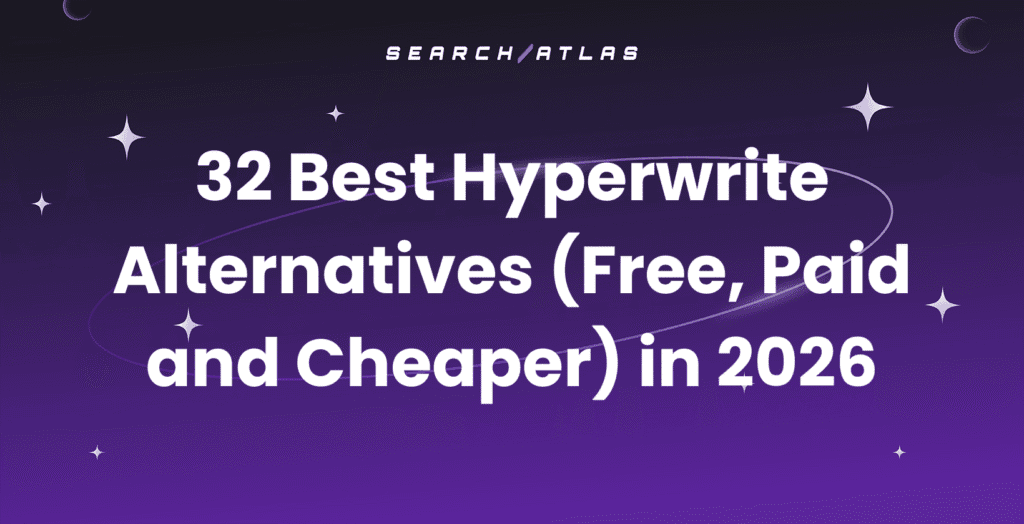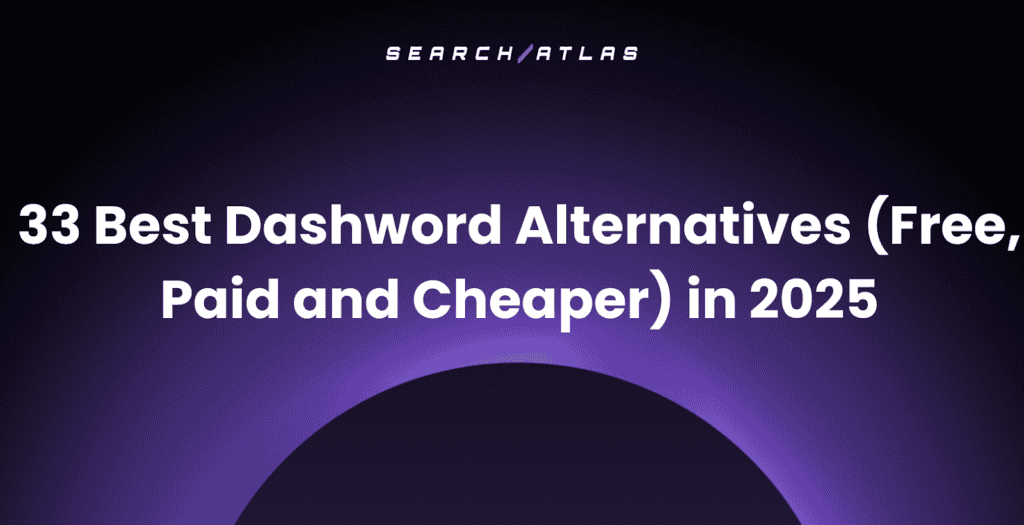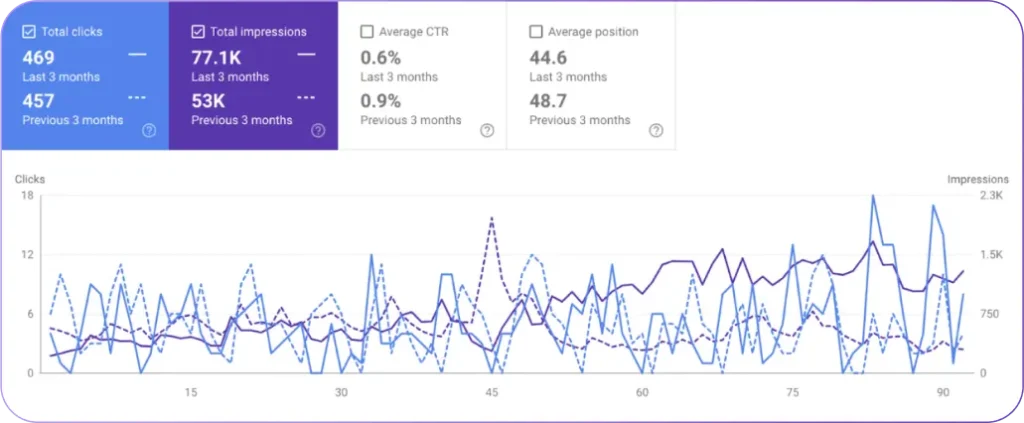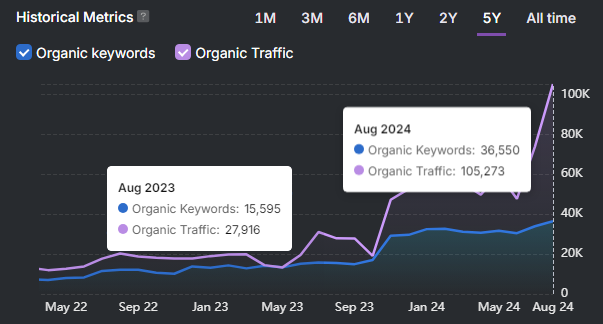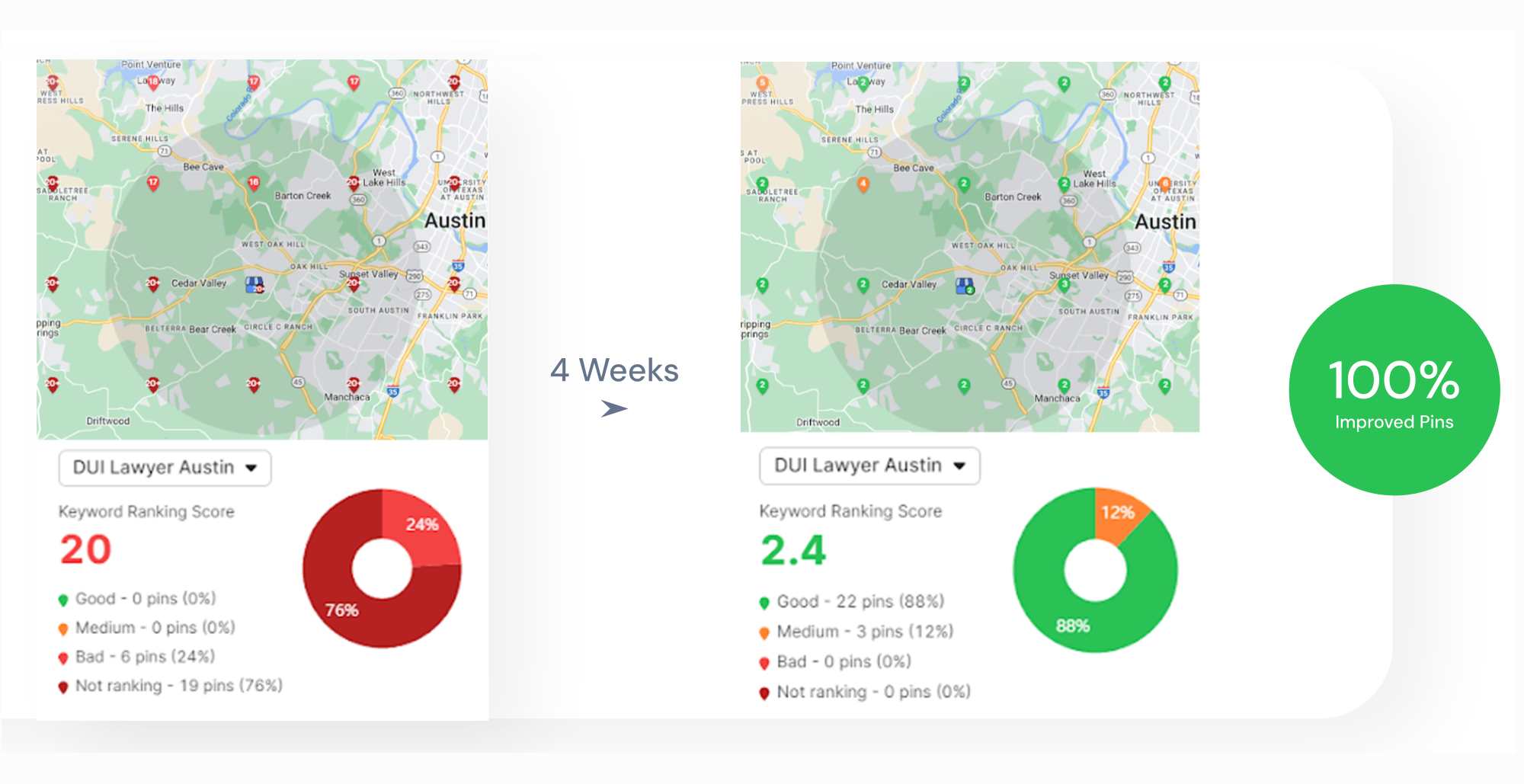Writesonic is an AI-powered content creation platform with over 80 features for generating SEO-optimized content, articles, ad copy, and product descriptions. Writesonic supports content marketers, businesses, and agencies that need to scale content production, optimize for search engines, and create brand-consistent messaging across multiple platforms. Writesonic AI integrates with major SEO tools and offers access to multiple AI models, including GPT-4, Claude, and Gemini.
The most-used features of Writesonic include AI Article Writer, SEO Checker & Optimizer, and Chatsonic. Writesonic pricing ranged from $20/month to $1,499/month for the Basic plan and goes up to $499/month. The standout pros in the Writsonic review include comprehensive AI model integration and real-time research capabilities. Considering cons, Writesonic faces challenges with customer support responsiveness and output consistency that require manual editing for professional use.
What is Writesonic?
Writesonic is an AI-powered content and SEO platform that combines content generation, optimization, and publishing in one unified workspace. Writesonic supports marketing teams that need scalable content, search visibility, and workflow automation using real-time data and multiple large language models. Writesonic matters because it replaces fragmented tools with an integrated system that improves efficiency, ranking performance, and brand consistency.
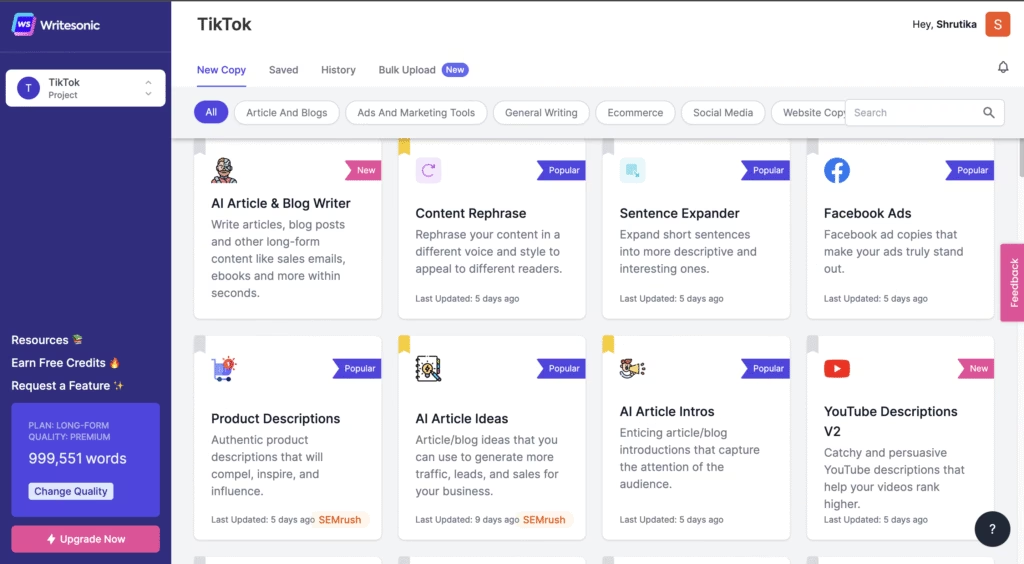
Writesonic includes more than 80 tools for research, writing, editing, and publishing. The Writesonic platform connects to SEO data sources like Ahrefs, Google Analytics (GA4), and Google Search Console (GSC), which allows users to generate content backed by competitor insights and live keyword trends. Writesonic supports AI models such as GPT-4o, Claude 3.5, Gemini 1.5 Pro, and its own o1 and o3-mini agents optimized for marketing content.
Writesonic allows users to upload documents, analyze files for insights, and repurpose existing content into new formats. It combines research automation, brand voice training, internal linking recommendations, and content scoring in one interface. Writers use Writesonic to produce SEO-ready blog posts, ads, emails, and landing pages faster than with standard chat tools or disconnected CMS workflows.
Writesonic integrates with WordPress, social media platforms, and analytics tools. The system includes data ingestion, AI image generation, collaborative editing, and publishing automation. These features allow teams to execute content marketing strategies from research to publication without switching tools.
What is the History of Writesonic?
Writesonic is a San Francisco-based AI content company founded in 2020 by Samanyou Garg. The company began under the name Magicflow before rebranding to Writesonic. The founder, Samanyou Garg, launched Writesonic to address the inefficiencies of manual content creation by applying artificial intelligence to marketing workflows.
Writesonic secured $2.5 million in seed funding through Y Combinator and other investors in 2021. The company added platform integrations, support for GPT-3, GPT-4, and Claude, and launched Chatsonic as a competitive alternative to ChatGPT. Writesonic evolved from a writing tool into an end-to-end SEO and publishing platform. By 2025, Writesonic served over 10 million marketers globally and reached a valuation of over $250 million through product expansion, data integrations, and real-time content capabilities.
Who is Writesonic Tool For?
Writesonic is for content marketers, digital agencies, small businesses, and enterprise teams that produce high volumes of written content. Writesonic supports organizations that require consistent messaging, scalable content generation, and multilingual output across multiple platforms. Writesonic works best for teams with 10 to 100 employees that manage multiple accounts, create SEO-optimized content, and require workflow integrations.
Writesonic helps digital agencies deliver uniform content across clients, while small businesses use it to compete with larger brands. Writesonic benefits enterprise teams that want to standardize content production, automate optimization, and reduce manual effort. Teams choose Writesonic to write, edit, optimize, and publish at scale without switching between tools.
What are the Writesonic Features?
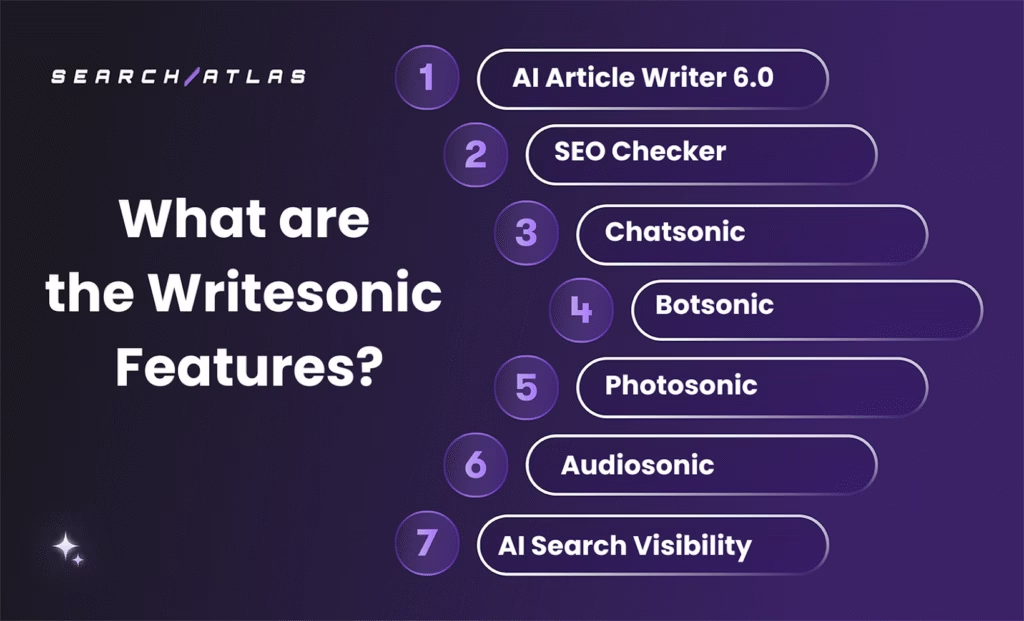
Writesonic features support AI content generation, chatbot automation, on-page SEO, marketing copywriting, visual content creation, and audio narration. Writesonic organizes its tools around typical content workflows, which allows creators, marketers, and SEO teams to write, optimize, repurpose, and distribute content across platforms from one AI-powered dashboard.
The 7 main Writesonic features and their use cases are listed below.
1. AI Article Writer 6.0
AI Article Writer 6.0 feature in Writesonic creates long-form blog posts and SEO-optimized articles of up to 5000 words. The AI Article Writer workflow includes structured steps like entering a topic, selecting references, adding primary and secondary keywords, choosing a title, and finalizing an outline. The Writersonic AI Article Writer tool uses GPT-4/32K and offers advanced options like brand tone control and SurferSEO integration.
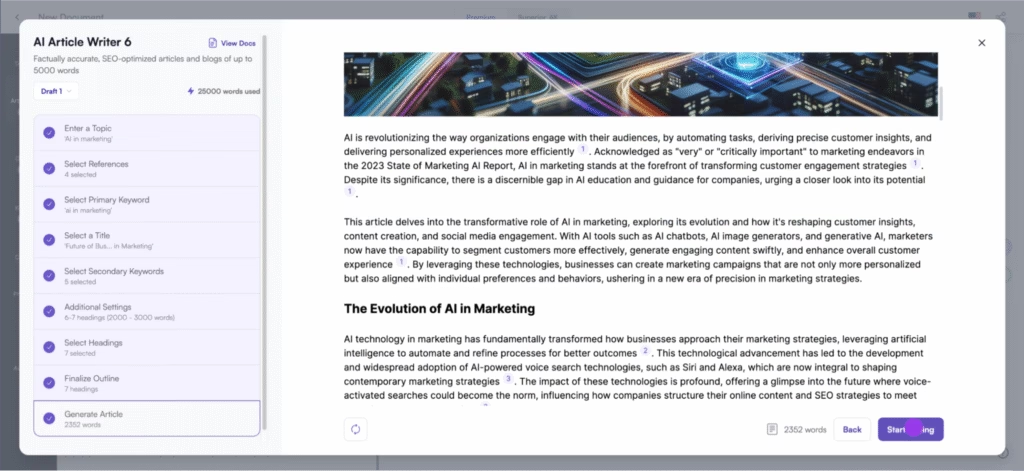
The AI Article Writer benefits marketers, publishers, and SEO professionals who need to generate factual, search-optimized content across niches. It reduces drafting time, supports multilingual content, and enforces SEO guidelines at every stage, which is ideal for agencies that manage multiple content pipelines.
For example, a user researching “AI in marketing” uploads four reference links, selects 5 secondary keywords, and requests an article between 2000 and 3000 words with 7 headings. The Writesonic AI Writer produces a complete first draft (e.g., 2352 words) that includes headings, citations, and meta-aligned structure, ready for editorial review or CMS publishing.
2. SEO Checker and Optimizer
The SEO Checker and Optimizer feature in Writesonic scans content for keyword coverage, heading structure, and competitive gaps using real-time Google data. The Writesonic SEO Checker and Optimizer assigns a Content SEO Score, flags missing semantic elements, and auto-generates improvement suggestions inside the content editor.
The SEO Checker and Optimizer feature supports SEO teams that assess optimization strength before publishing. It detects keyword dilution, missing headers, low paragraph density, and lack of media elements in English and multilingual drafts. The built-in “Improve SEO” button rewrites and adjusts SEO content to raise optimization scores instantly.

Writers often paste long-form drafts to identify ranking blockers, such as underused semantic phrases or keyword stuffing. After applying the suggested edits, content typically shows increased topical coverage and clearer formatting, which improves SERP positioning for target keywords.
3. Chatsonic
The Chatsonic feature in Writesonic functions as an AI marketing agent that combines GPT-4o, Claude 3.5, Gemini 1.5, and Flux 1.1 into one chat interface. The Chatsonic AI agent integrates real-time data sources like Ahrefs, WordPress, and Google Search Console to assist with writing, optimization, publishing, and reporting inside the same workspace. Marketers use Chatsonic to run full campaign workflows from a single conversational thread.
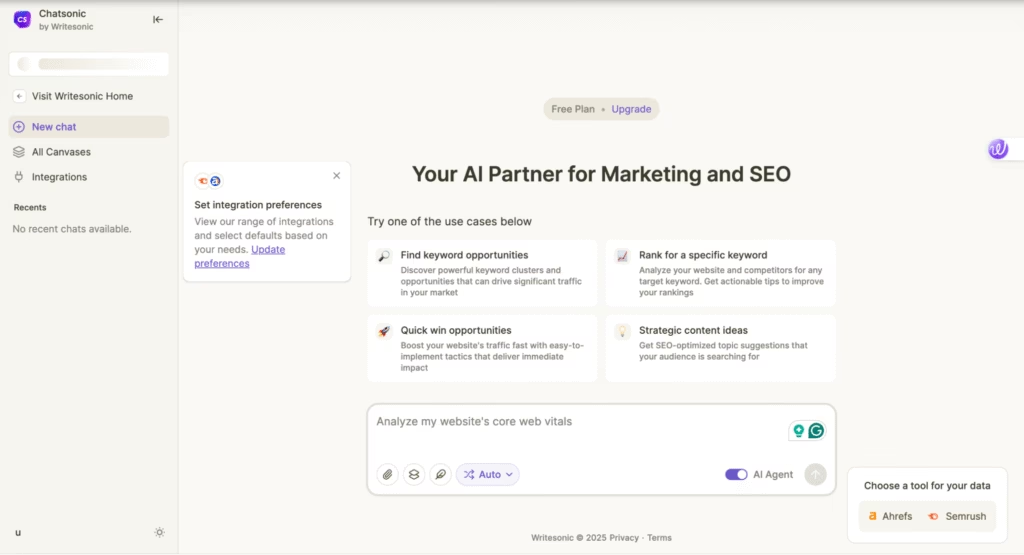
The Chatsonic feature benefits digital marketers, content strategists, and growth teams who manage cross-platform content execution. The Chatsonic speeds up content ideation, supports brand voice enforcement, and eliminates tool-switching across keyword research, on-page optimization, and analytics reporting. Advanced settings allow users to switch AI models, preview content types, or embed interactive assets into prompts and responses.
For example, a content strategist launches Chatsonic to generate a blog post about “ecommerce personalization trends.” They select Claude 3.5, upload PDF research, pull keyword suggestions via Ahrefs integration, and request branded tone output. Within 90 seconds, Chatsonic delivers a structured article with data summaries, citations, internal links, and a preview-ready HTML block ready for WordPress publishing.
5. Botsonic (Custom AI Chatbot Builder)
The Botsonic feature in Writesonic builds AI chatbots that automate support, sales, and employee interactions by training directly on your website, documents, and help center data. The Botsonic AI agent uses a model-agnostic gateway (GPT Router) that dynamically selects the best LLM for each query while maintaining zero retention on user data. Users embed the chatbot across the web, WhatsApp, SMS, and internal tools after customizing its behavior and appearance.
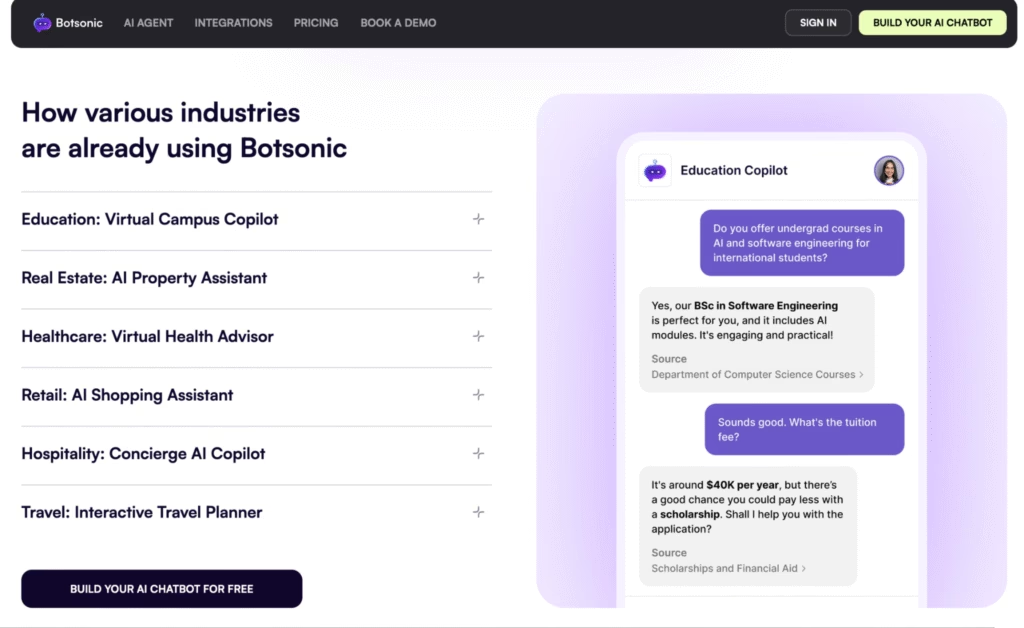
The Botsonic feature supports teams that automate high-volume queries, reduce support costs, and enhance real-time engagement across global audiences.
Botsonic resolves 70% of common requests with precise, verified responses in 50+ languages. Use cases include 24/7 customer support, automated employee onboarding, and conversational commerce workflows in industries like SaaS, ecommerce, healthcare, and education.
6. Photosonic
The Photosonic feature in Writesonic converts written prompts into high-quality images across visual styles such as photorealism, abstract art, and digital illustrations. The Photosonic image generator supports horizontal, vertical, and square formats and generates up to five images per prompt. Users can enhance prompts, upscale resolution, and export visuals for royalty-free use across digital platforms.
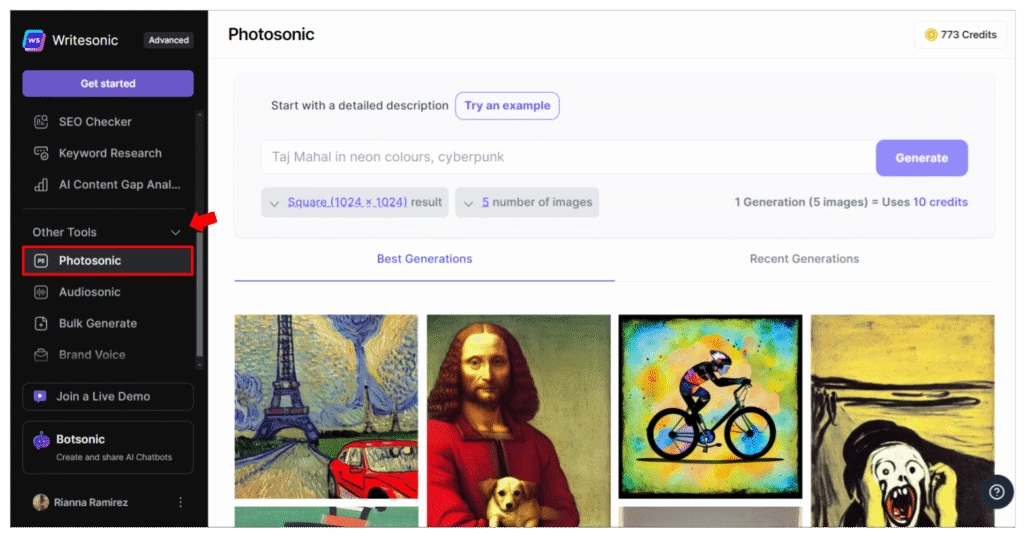
The Photosonic feature benefits marketers, content creators, designers, and educators who need unique, fast-turnaround visuals without relying on stock photos or design software. It supports blog illustrations, ad creatives, product concepts, and educational diagrams with visual coherence and cost efficiency.
For example, a user enters the prompt “A minimalist workspace with a laptop, coffee cup, and houseplant on a wooden desk, in soft morning light.” Photosonic returns five high-resolution image variants sized for Instagram, blog headers, and slide decks. The user selects one, upscales the image, and exports it for a new blog post design without manual edits or licensing issues.
7. Audiosonic
The Audiosonic feature in Writesonic converts written text into lifelike speech using advanced voice synthesis. The Audiosonic feature supports multiple voices, preview playback, text rewriting, and audio exports for marketing, learning, and accessibility use cases. Audiosonic delivers human-like tone, clarity, and intonation in seconds and allows commercial usage with flexible pricing options.
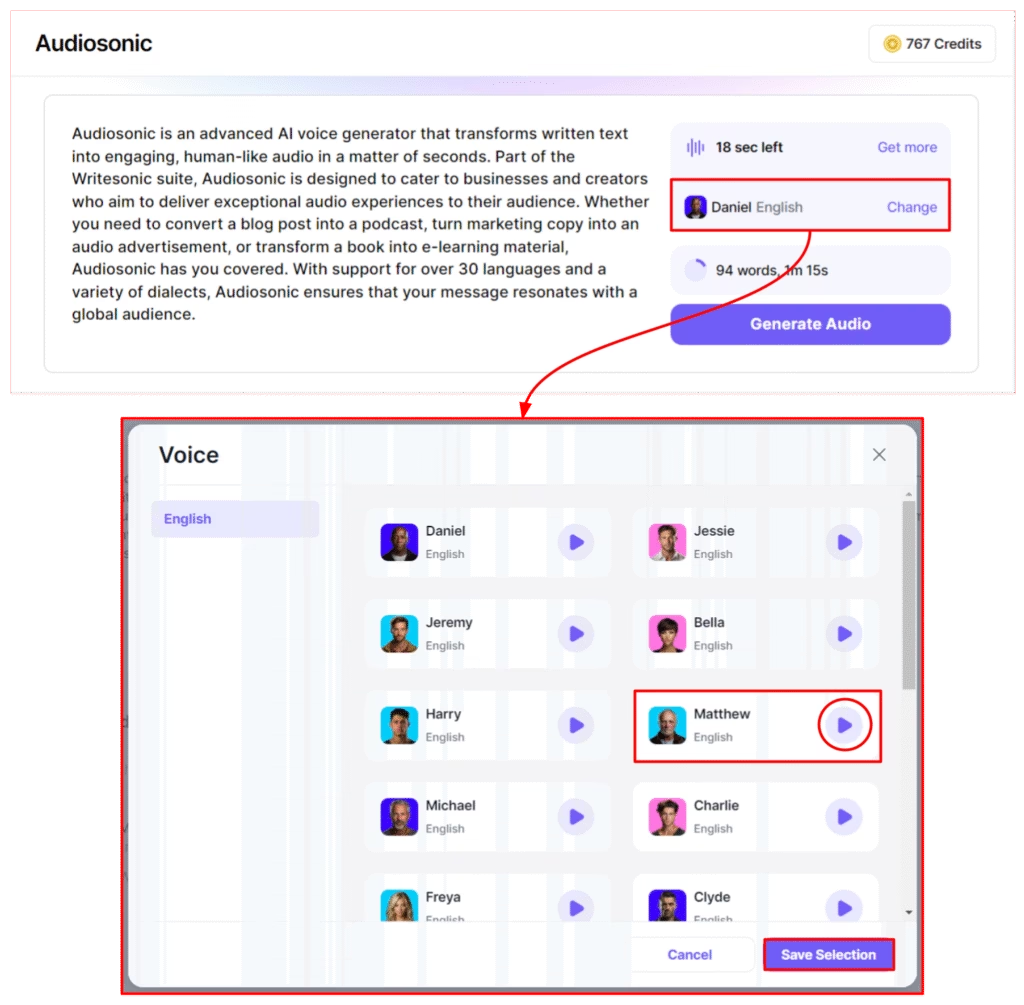
The Audiosonic feature helps marketers, educators, and content teams deliver audio-based formats without hiring voice talent. It speeds up podcast production, enhances e-learning with narration, and creates multilingual support content for wider reach.
For example, a team repurposes a blog post on “Top SEO Trends for 2025” into a 4-minute voice clip. After selecting a conversational female voice and adjusting the tone in Audiosonic, they generate a ready-to-publish audio version for their site’s accessibility section and podcast teaser, without manual recording or post-processing.
8. AI Search Visibility (GEO)
AI Search Visibility, or Generative Engine Optimization (GEO), is a Writesonic feature that tracks how often a brand appears in AI-generated answers across ChatGPT, Google AI Overviews, Perplexity, Gemini, Claude, and other platforms. Writesonic GEO benchmarks visibility, ranking position, and sentiment against competitors.
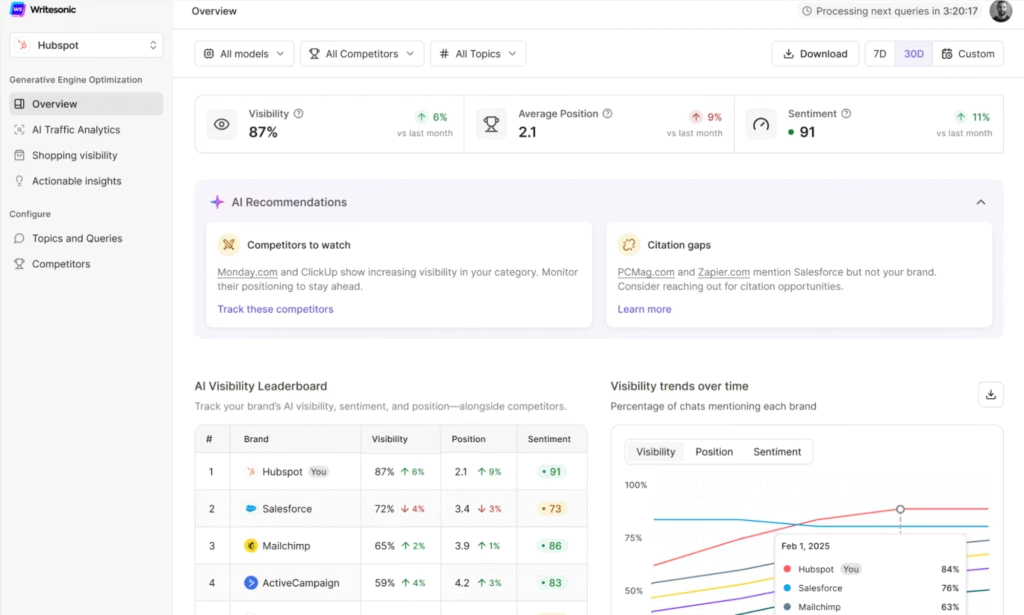
The Writesonic GEO tool shows which prompts, pages, and citation sources affect brand visibility. It compares performance across topics, tracks visibility trends over time, and identifies competitors gaining share.
Users analyze citation gaps, receive optimization prompts, and understand AI-generated phrasing about their brand. AI Search Visibility helps digital marketers influence large language model (LLM) outputs and align content strategy with how AI presents entities in live environments.
How does Writesonic Tool Work?
Writesonic tool works by processing user inputs, such as topic, keywords, tone, and goals, using multiple large language models and SEO systems to generate optimized content. Writesonic directs inputs into models like GPT‑4o, Claude 3.5, Gemini 1.5 Pro, and proprietary agents (o1, o3‑mini). These models draw on real‑time research via Ahrefs, Google Analytics, Search Console, competitor data, and Reddit before generating structured content with headlines, citations, internal links, and meta tags. Users edit and refine drafts with Live SEO Checker, Optimize Content, and Brand Voice tools, then publish to WordPress and social media directly from the interface.
Writesonic integrates in-project site health tools (Site Audit for technical SEO, AI Traffic Analytics for LLM visibility) alongside over 170 issue checks. The platform applies AI agents to spot content gaps, crawls, and indexing problems before publication and prompts automatic fixes. Internal linking suggestions and on-page optimization features work during drafting and post-publish auditing.
How Accurate is Writesonic Tool?
Writesonic tool accuracy depends on the topic complexity, input quality, and real-time data integration. Writesonic mostly generates reliable content for general business topics, which include marketing, eCommerce, and productivity.
Writesonic uses GPT-4, Claude, and Gemini to generate factually grounded text, which sometimes leads to errors. The Writesonic Chatsonic assistant connects to current web data, which increases accuracy for trending topics and time-sensitive queries. The SEO Checker feature supports keyword relevance, readability, and optimization patterns, which improve technical accuracy in ranking content.
Writesonic accuracy improves when users provide detailed prompts, specific brand instructions, and clearly defined target outcomes. Uploading brand voice samples and content examples trains the AI to follow the expected tone, structure, and terminology. Teams that use structured prompts and edit final drafts produce more accurate, conversion-focused content.
Writesonic performs best on broad subjects and evergreen content. Technical fields such as finance, healthcare, and law require manual fact-checking, citation replacement, and precision editing to meet professional standards.
What Pricing Plans Does Writesonic Tool Offer?
Writesonic offers five paid pricing plans from $20 to $1,499+ per month, each with scalable access to users, projects, and AI-powered content workflows. Writesonic uses a flat-rate structure with upgradeable modules for AI generations, brand voice profiles, SEO audits, and GEO (Generative Engine Optimization) tracking. Writesonic pricing matters because it determines access to key tools like the AI Article Writer, SEO AI Agent, and AI Traffic Analytics.
The Writesonic Basic plan ($20/month) includes 1 user, 1 project, 10 AI Agent generations, 5 articles, and 3 site audits.
The Lite plan ($49/month) expands limits to 100 generations, 15 articles, and 6 audits, plus 2 brand voice styles.
The Standard plan ($99/month) includes 2 projects, 30 articles, 15 audits, and advanced features such as Brand Presence Tracking (GEO), automatic SEO fixes, and Google Analytics integration.
The Professional plan ($249/month) supports 2 users, 3 projects, 100 articles, and 40 audits with access to GPT-4o mini, API tools, and unlimited brand voice profiles.
The Advanced plan ($499/month) includes 5 users, 4 projects, 200 articles, and 60 audits, along with full GEO access, project scaling, and site analysis depth.
The Enterprise plan (from $1,499/month) adds custom user limits, legal reviews, training, and advanced admin controls for large teams managing multiple domains and SEO channels.
Each plan includes unlimited Chatsonic generations (under fair use), SEO AI Agent access, and multi-step site audits. Projects and users are priced as add-ons, ranging from $40 to $149 per seat or project. Annual billing includes a 20% discount across all plans.
Writesonic tool proves itself worth the price for users who produce content in bulk and need AI assistance.
What is the Writesonic Tool Rating?
The Writesonic tool rating is consistently high across major software review platforms, with an average rating of 4.7 out of 5. The ratings reflect user satisfaction with content generation quality, AI model access, and SEO integration features.
The Writesonic tool ratings across five platforms are listed below.
- G2. 4.7/5 (2,029 reviews).
- Capterra. 4.8/5 (2102 reviews).
- Trustpilot. 4.7/5 (5902 reviews).
- TrustRadius. 8.1/10 (4 reviews).
- Product Hunt. 4.7/5 (373 reviews).
Writesonic tool reviews show that Writesonic performs well for fast content production, SEO workflows, and marketing automation. Negative reviews mention billing complexity, support delays, and inconsistent quality on technical topics.
What are the Pros of Writesonic?
The pros of Writesonic relate to its speed, SEO-focused toolset, and accessibility for marketers and content teams. The pros of Writesonic are given below.
- Fast Content Generation. Writesonic produces blog posts, landing pages, product descriptions, and ad copy significantly faster than manual writing or outsourcing.
- Multiple AI Models. Users can choose between GPT-3.5, GPT-4, Claude, and GPT-4o depending on the plan, which improves control over output tone and accuracy.
- Built-In SEO Tools. Writesonic includes keyword insertion, meta description generation, and AI traffic analytics for improving search visibility.
- Customizable Brand Voice. Writing Style settings allow teams to adjust tone, structure, and language preferences across different content types and clients.
- Versatile Use Cases. The tool supports social media content, email sequences, product descriptions, and long-form articles from the same dashboard.
- Regular Feature Updates. New tools and AI agents are introduced frequently, including integrations for Google Analytics, GSC, and ChatGPT 4o.
- Broad Integration Options. Writesonic integrates with CMS platforms, publishing tools, and SEO analytics to fit into existing workflows.
Writesonic is particularly useful for small teams, agencies, or marketers who need to scale content production quickly without sacrificing SEO visibility or brand tone.
What are the Cons of Writesonic?
The cons of Writesonic relate to quality inconsistencies, usage limitations, and content refinement needs. The cons of Writesonic are given below.
- Variable Content Quality. Users report that long-form or technical content sometimes includes inaccuracies or filler, especially with short prompts.
- Usage Restrictions on Lower Plans. Entry-level tiers include monthly caps on generations, articles, and audits, which limit scalability for high-volume needs.
- Overwhelming Interface. Some reviewers find the dashboard cluttered or confusing due to the large number of modules and similar tool names.
- Lacking Deep Collaboration Features. Writesonic does not offer advanced team permissions, shared editing, or real-time collaboration features for agencies.
- Post-Generation Editing Required. Outputs often need fact-checking, SEO refinement, or stylistic adjustments before publication.
- Prompt-Dependent Results. The quality and structure of results heavily rely on how well prompts are crafted, which increases the learning curve for new users.
These drawbacks may limit the effectiveness of Writesonic for users who need highly accurate, deeply optimized, or collaboratively produced content at scale.
What do Reddit Users think about Writesonic?
Reddit users share mixed but predominantly negative views about Writesonic. A few mention that Writesonic is useful for quick drafts and supports integrations like FusionOS. However, even some active users admit they often need to rewrite or edit most of the AI-generated content to match their expectations.

Most Reddit comments highlight major downsides. Several users criticize Writesonic for billing issues, with reports of unauthorized charges and unresponsive customer support. Others say the output quality lags behind ChatGPT or Claude and lacks the flexibility of prompt-based tools.
Some note that Writesonic’s core engine is just a repackaged version of ChatGPT, but priced at a significant markup. One Redditor said bluntly, “I hated it,” while another called it “a bad product” with “shady business practices.”
These reviews suggest that while Writesonic has some practical use cases, many Reddit users view it as overpriced and unreliable compared to direct access to foundational models like OpenAI or Anthropic.
How does Writesonic treat its Long-term Subscribers?
Writesonic offers loyalty benefits such as credit increases, discounted annual pricing, and early feature access for long-term subscribers. Long-term users on higher-tier plans receive priority support, beta access to experimental tools like SEO AI Agent and Chatsonic upgrades, and account management assistance for team onboarding. Writesonic matters for recurring users because it provides continuity, system familiarity, and pricing stability during platform expansion.
G2 reviewers confirm that Writesonic maintains stable pricing for loyal customers and frequently rolls out usability improvements and added features at no extra cost. Subscribers who renew on annual plans gain more credits per dollar and receive first access to new tools like AI Traffic Analytics and Generative Engine Optimization (GEO) modules. Reddit threads show appreciation for the ability to retain trained brand voice models and historical projects without disruption.
How Responsive is Writesonic’s Customer Support?
Writesonic support responsiveness varies by plan and issue type, with free users reporting delays and Pro subscribers receiving faster resolutions. Writesonic provides support through chat, email, and a Help Center, but reviews consistently mention slow replies for billing and credit issues. Customer support matters because it directly affects productivity, billing accuracy, and trust.
According to G2 reviewers, most users on standard or professional tiers receive email responses within 24 to 48 hours. However, users on free or lite plans frequently describe inconsistent access to support, unclear credit explanations, and delayed issue resolution. Reddit feedback indicates that live chat is often unavailable or routed to automated flows. Users recommend planning around support delays if using lower-tier plans or the free trial.
How Reliable and Legit is Writesonic as an SEO Tool?
Writesonic is a reliable and legitimate SEO content tool with real-time integrations, enterprise-grade encryption, and global user adoption. The Writesonic company is SOC 2 certified, GDPR and HIPAA compliant, and backed by Y Combinator, with over 30,000 teams using the product.
However, Reddit threads reveal patterns of unresolved billing issues, denied refunds, and blocked cancellations. Multiple users describe Writesonic as a scam due to unauthorized charges after account deactivation and an unclear refund policy. These reports indicate reliability risks on the financial operations side, even though the technical platform itself functions as described.
What is the Best Alternative to Writesonic?
The best alternative to the Writesonic tool is the Search Atlas SEO Software Platform. Search Atlas replaces Writesonic for key AI content workflows by combining article generation, SEO scoring, publishing, optimization, and automation in one platform. Writesonic generates content based on templates, but Search Atlas creates long-form pages that rank, using real-time data from Google Search Console and built-in SERP emulation.
Search Atlas supports brand voice guidelines across every article with topic-driven outlines, internal link automation, and paragraph-level SEO scoring. Content Genius matches NLP entities, aligns outputs with Helpful Content expectations, and flags missing schema or headings. Writers generate, revise, and score content in a single editor, without switching tools. Writesonic provides text generation with limited post-processing and no connected SERP intelligence.
Search Atlas supports full publishing pipelines with direct CMS export, schema automation, and on-page deployment using OTTO SEO. Users can publish directly to WordPress with optimized tags, FAQs, and internal links prebuilt. Writesonic exports drafts for manual editing. For programmatic SEO and localized pages, Search Atlas supports thousands of URLs with AI-filled templates and pre-scheduled GSC optimization.
Search Atlas starts at $99/month with unlimited projects, AI writing, and optimization. It includes a 7-day trial and usage-based pricing for OTTO SEO deployment.
Search Atlas is the best Writesonic alternative for teams that need SERP-aligned writing, real-time scoring, CMS integration, and AI-powered SEO execution at scale.
Migrate from Writesonic to Search Atlas to write content that actually ranks, and publish it without manual cleanup or technical blockers.
Are there any other Writesonic Alternatives?
Yes, several Writesonic alternatives offer overlapping features for content generation, SEO optimization, and AI workflows. Jasper rivals Writesonic in brand voice enforcement and multi-channel campaigns, especially for enterprise teams. Content at Scale focuses on undetectable AI writing and long-form SEO articles at bulk scale. Frase and Surfer SEO specialize in on-page optimization and topic modeling, making them strong complements or replacements for Writesonic’s SEO tools. For those who need Writesonic alternatives with wide technical SEO tools and AI content creation under one platform, Search Atlas offers a broader feature set, including GSC integration, rank tracking, and real-time optimization.
Do SEO professionals rank Writesonic among the best SEO tools?
Yes, Writesonic ranks among the best SEO tools for AI article writing, topic research, CMS publishing, and brand voice control.
SEO professionals value the Writesonic AI Article Writer 6.0 for generating long-form, search-optimized drafts with brand tone settings and integrated keyword workflows. Writesonic supports multilingual output, SurferSEO integration, and auto-publishing to WordPress, which streamlines content pipelines for agencies and publishers.
However, for advanced SEO tasks like technical audits, backlink analysis, and rank tracking, experts pair Writesonic with premium all-in-one SEO tools like Search Atlas to complete the workflow.






